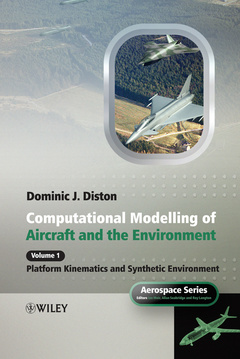Description
Computational Modelling and Simulation of Aircraft and the Environment, Volume 1
Platform Kinematics and Synthetic Environment
Aerospace Series
Author: Diston Dominic J.
Directors of collection: Moir Ian, Seabridge Allan, Langton Roy
Language: English
Keywords
guide; derivation; first; computational; environment; comprehensive; volume; aircraft; modelling; synthetic; reader; information; able; architecture; sufficient; basic; relevant; highly; multidisciplinary; models; integrated
382 p. · 17.3x25.2 cm · Hardback
Description
/li>Contents
/li>Biography
/li>
All major principles with this book are demonstrated using MATLAB and the detailed mathematics is developed progressively and fully within the context of each individual topic area, thereby rendering the comprehensive body of material digestible as an introductory level text. The author has drawn from his experience as a modelling and simulation specialist with BAE SYSTEMS along with his more recent academic career to create a resource that will appeal to and benefit senior/graduate students and industry practitioners alike.
Acknowledgements.
List of Abbreviations.
How To Use This Book.
Series Preface.
Chapter 1: Introduction.
1.1 Computational Modelling.
1.2 Modelling and Simulation (M&S).
1.3 Development Processes.
1.4 Models.
1.5 Meta-models.
1.6 Aerospace Applications.
1.7 Integration and Interoperability.
1.8 The End of the Beginning.
Chapter 2: Platform Kinematics.
2.1 Axis Systems.
2.2 Changing Position and Orientation.
2.3 Rotating Axis Systems.
2.4 Quaternions.
2.5 Line of Sight.
Chapter 3: Geospatial Reference Model.
3.1 Spherical Earth.
3.2 Spherical Trigonometry.
3.3 Great Circle Navigation.
3.4 Rhumb Line Navigation.
3.5 Reference Ellipsoids.
3.6 Coordinate Systems.
3.7 Navigation on an Ellipsoidal Earth.
3.8 Mapping.
3.9 General Principles of Map Projection.
3.10 Mercator Projection .
3.11 Transverse Mercator Projection.
3.12 Conformal Latitude.
3.13 Polar Stereographic Projection.
3.14 Three-Dimensional Mapping.
3.15 Actual Latitudes, Longitudes and Altitudes.
Chapter 4: Positional Astronomy.
4.1 Earth and Sun.
4.2 Observational Reference Frames.
4.3 Measurement of Time.
4.4 Calendars and the J2000 Reference Epoch.
4.5 Chronological Scale.
4.6 Astrometric Reference Frames.
4.7 Orbital Mechanics.
4.8 Solar System Orbit Models.
4.9 GPS Orbit Models.
4.10 Night Sky.
Chapter 5: Geopotential Fields.
5.1 Potential Fields.
5.2 Gravitation.
5.3 Geomagnetism.
5.4 Geopotential Computation.
5.5 Final Comment on Geopotential Models.
Chapter 6: Atmosphere.
6.1 Overview.
6.2 Standard Atmosphere Models.
6.3 ISA Constants and Relationships.
6.4 Geopotential Altitude.
6.5 Vertical Structure of the Atmosphere.
6.6 Pressure Altitude.
6.7 Reference Atmospheres.
6.8 Seasonal Variation.
6.9 Climatic Regions.
6.10 Air Density.
6.11 Water Vapour.
6.12 Weather Systems.
Appendix A: Introduction to MATLAB.
A. 1 MATLAB.
A. 2 The MATLAB Product Family.
A. 3 Getting Started.
A. 4 Getting Help.
A. 5 Where?
A. 6 Numbers: Variables and Literals.
A. 7 Arithmetic.
A. 8 Logic.
A. 9 M-Files and Functions.
A.10 Built-in Functions.
A.11 Constants.
A.12 Creating Graphs.
A.13 Summary of Appendix A.
Appendix B: Data and Function.
B.1 Types of Data.
B.2 Data Type Descriptions.
B.2.1 ‘double’.
B.2.2 ‘logical’.
B.2.3 ‘char’.
B.2.4 ‘cell’.
B.2.5 ‘struct’.
B.2.6 ‘function_handle’.
B.3 Program Structure.
B.3.1 Syntax.
B.3.2 Conditional Execution.
B.3.3 Iterative Execution.
B.3.4 Exception Handling.
B.3.5 Omissions.
B.4 User-defined Functions.
B.4.1 Interfacing.
B.4.2 Generic Functions.
B.4.3 Recursive Functions.
B.4.4 Private Functions.
B.5 User-defined Classes.
B.6 Practical Implementation.
B.6.1 Naming Convention.
B.6.2 Program Architecture.
B.6.3 Precedence.
B.6.4 Preferences.
B.7 Summary of Appendix B
Appendix C: Organisations.
C.1 Specialist Agencies of the United Nations.
C.2 International Organisations.
C.3 US Government Organisations.
C.4 UK Government Organisations.
C.5 European Organisations.
C.6 Open Projects and Consortia.
Bibliography.
Index.
Dr Dominic Diston until recently was JSF UK Modelling and Simulation Co-ordinator at BAE Systems, UK. In January 2005 he took up a teaching post at Manchester University.




